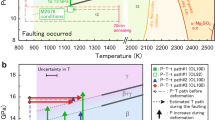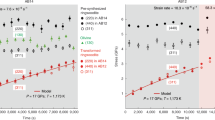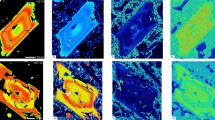Abstract
Tectonic plate motion is thought to cause solid-state plastic flow within the underlying upper mantle and accordingly lead to the development of a lattice preferred orientation of the constituent olivine crystals1,2,3. The mechanical anisotropy that results from such preferred orientation typically produces a direction of maximum seismic wave velocity parallel to the plate motion direction4,5. This has been explained by the existence of an olivine preferred orientation with an ‘a-axis’ maximum parallel to the induced mantle flow direction3,5,6,7,8. In subduction zones, however, the olivine a axes have been inferred to be arranged roughly perpendicular to plate motion9,10,11,12,13, which has usually been ascribed to localized complex mantle flow patterns10,11,12,13. Recent experimental work14 suggests an alternative explanation: under conditions of high water activity, a ‘B-type’ olivine preferred orientation may form, with the a-axis maximum perpendicular to the flow direction. Natural examples of such B-type preferred orientation are, however, almost entirely unknown. Here we document widespread B-type olivine preferred orientation patterns from a subduction-type metamorphic belt in southwest Japan and show that these patterns developed in the presence of water. Our discovery implies that mantle flow above subduction zones may be much simpler than has generally been thought.
This is a preview of subscription content, access via your institution
Access options
Subscribe to this journal
Receive 51 print issues and online access
$199.00 per year
only $3.90 per issue
Buy this article
- Purchase on Springer Link
- Instant access to full article PDF
Prices may be subject to local taxes which are calculated during checkout




Similar content being viewed by others
References
Nicolas, A. & Christensen, N. I. Formation of anisotropy in upper mantle peridotites—a review. In Composition, Structure and Dynamics of the Lithosphere-Asthenosphere System (eds Fuchs, K. & Froideoaux, C.) 111–123 (1987)
Carter, N. L. & Ave'Lallemant, H. G. High temperature flow of dunite and peridotite. Geol. Soc. Am. Bull. 81, 2181–2202 (1970)
Zhang, S. & Karato, S. Lattice preferred orientation of olivine aggregates deformed in simple shear. Nature 375, 774–777 (1995)
Raitt, R. W., Shor, G. G., Francis, T. J. G. & Morris, G. B. Anisotropy of the Pacific upper mantle. J. Geophys. Res. 74, 3095–3109 (1969)
Christensen, N. I. The magnitude, symmetry and origin of upper mantle anisotropy based on fabric analyses of ultramafic tectonites. Geophys. J. R. Astron. Soc. 76, 89–111 (1984)
Hess, H. H. Seismic anisotropy of the uppermost mantle under oceans. Nature 203, 629–631 (1964)
Francis, T. J. G. Generation of seismic anisotropy in the upper mantle along the mid-oceanic ridges. Nature 221, 162–165 (1969)
Peselnick, L., Nicolas, A. & Stevenson, P. R. Velocity anisotropy in a mantle peridotite from the Ivrea zone: application to upper mantle anisotropy. J. Geophys. Res. 79, 1175–1182 (1974)
Ando, M., Ishikawa, Y. & Yamazaki, F. Shear wave polarization anisotropy in the upper mantle beneath Honshu, Japan. J. Geophys. Res. 88, 5850–5864 (1983)
Shih, X. R., Schneider, J. F. & Meyer, R. P. Polarities of P and S waves, and shear wave splitting observed from the Bucaramanga Nest, Colombia. J. Geophys. Res. 96, 12069–12082 (1991)
Yang, X. & Fischer, K. M. Seismic anisotropy beneath the Shumagin Islands segment of the Aleutian-Alaska subduction zone. J. Geophys. Res. 100, 18165–18177 (1995)
Fouth, M. J. & Fischer, K. M. Mantle anisotropy beneath northwest Pacific subduction zones. J. Geophys. Res. 101, 15897–16002 (1996)
Smith, G. P. et al. A complex pattern of mantle flow in the Lau backarc. Science 292, 713–716 (2001)
Jung, H. & Karato, S. Water-induced fabric transitions in olivine. Science 293, 1460–1463 (2001)
Enami, M., Mizukami, T. & Yokoyama, K. Metamorphic evolution of garnet-bearing ultramafic rocks from the Gongen area, Sanbagawa belt, Japan. J. Metamorph. Geol. 22, 1–15 (2004)
Yoshino, G. Structural-petrological studies of peridotite and associated rocks of the Higashi-akaishi-yama District, Shikoku, Japan. J. Sci. Hiroshima Univ. C 3, 343–402 (1961)
Banno, S. & Sakai, C. Geology and metamorphic evolution of the Sanbagawa metamorphic belt, Japan. In Evolution of Metamorphic Belts (eds Daley, J. S., Cliff, R. A. & Yardley, B. W. D.) 519–532 (1989)
Takasu, A. & Dallmeyer, R. D. 40Ar/39Ar mineral age constraints for the tectonothermal evolution of the Sambagawa metamorphic belt, central Shikoku, Japan: a Cretaceous accretionary prism. Tectonophysics 185, 111–139 (1990)
Wallis, S. Exhuming the Sanbagawa metamorphic belt: the importance of tectonic discontinuities. J. Metamorph. Geol. 16, 83–95 (1998)
Mori, T. & Banno, S. Petrology of peridotite and garnet clinopyroxenite of the Mt. Higashi Akaishi mass, central Shikoku, Japan—subsolidus relation of anhydrous phases. Contrib. Mineral. Petrol. 41, 301–323 (1973)
Mercier, J.-C. C. & Nicolas, A. Textures and fabrics of upper-mantle peridotites as illustrated by xenoliths from basalts. J. Petrol. 16, 454–487 (1975)
Boudier, F. & Nicolas, A. Nature of the Moho transition zone in the Oman ophiolite. J. Petrol. 36, 777–796 (1995)
Hirai, H. & Arai, S. H2O–CO2 fluids supplied in alpine-type mantle peridotites: electron petrology of relic fluid inclusions in olivines. Earth Planet. Sci. Lett. 85, 311–318 (1987)
Harley, S. L. & Green, D. H. Garnet-orthopyroxene barometry for granulites and peridotites. Nature 300, 697–701 (1982)
Rossman, G. R. Vibrational spectroscopy of hydrous components. Rev. Mineral. 18, 193–206 (1988)
Acknowledgements
S. Wallis aided in the field studies for this work and was closely involved in developing the rationale for the study. J. Yamamoto carried out the laser micro-Raman spectroscopic analyses. We thank H. Kagi for his support during these analyses and for discussion on this work. We also thank M. Enami and M. Obata for their comments. This work was supported in part by a grant from the Fukada Geological Institute.
Author information
Authors and Affiliations
Corresponding author
Ethics declarations
Competing interests
The authors declare that they have no competing financial interests.
Rights and permissions
About this article
Cite this article
Mizukami, T., Wallis, S. & Yamamoto, J. Natural examples of olivine lattice preferred orientation patterns with a flow-normal a-axis maximum. Nature 427, 432–436 (2004). https://doi.org/10.1038/nature02179
Received:
Accepted:
Issue Date:
DOI: https://doi.org/10.1038/nature02179
This article is cited by
-
Analysis of electron backscattered diffraction (EBSD) mapping of geological materials: precautions for reliably collecting and interpreting data on petro-fabric and seismic anisotropy
Geosciences Journal (2020)
-
Fossilized Melts in Mantle Wedge Peridotites
Scientific Reports (2018)
-
Crystal preferred orientations of olivine, orthopyroxene, serpentine, chlorite, and amphibole, and implications for seismic anisotropy in subduction zones: a review
Geosciences Journal (2017)
-
Earth's oldest mantle fabrics indicate Eoarchaean subduction
Nature Communications (2016)
-
Homologous temperature of olivine: Implications for creep of the upper mantle and fabric transitions in olivine
Science China Earth Sciences (2016)
Comments
By submitting a comment you agree to abide by our Terms and Community Guidelines. If you find something abusive or that does not comply with our terms or guidelines please flag it as inappropriate.



